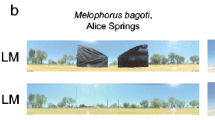Summary.
We examined visual navigation by Leptothorax albipennis, a small-eyed ant generally thought to orient principally with non-visual cues. We found that workers can use a prominent visual landmark for navigation between nest sites during colony emigration. When a landmark standing to one side of the ants' route was moved to the opposite side midway through an emigration, the ants' paths shifted toward the landmark's new position. The shift was apparent both at the point of departure from the old nest, and at the midpoint between nest sites. This result is consistent with the ants using the landmark as a beacon toward which they aim during the early stages of their journey. In contrast, no evidence was found for a simpler means of visual navigation in which the ants plot a course by consistently detouring to one side of a given landmark. When a landmark was shifted from one side to the centre of the ants' route, the ants did not adjust their paths to keep the landmark on the accustomed side.
Similar content being viewed by others
Author information
Authors and Affiliations
Additional information
Received 6 August 2001; revised 15 November 2001 and 26 February 2002; accepted 4 March 2002.
Rights and permissions
About this article
Cite this article
McLeman, M., Pratt, S. & Franks, N. Navigation using visual landmarks by the ant Leptothorax albipennis . Insectes soc. 49, 203–208 (2002). https://doi.org/10.1007/s00040-002-8302-2
Issue Date:
DOI: https://doi.org/10.1007/s00040-002-8302-2




